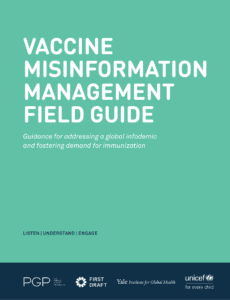Misinformation Alerts
Knowing what misinformation is being shared can help you generate effective messaging.
These insights are based on a combination of automated media monitoring and manual review by public health data analysts. Media data are publicly available data from many sources, such as social media, broadcast television, newspapers and magazines, news websites, online video, blogs, and more. Analysts from the Public Good Projects triangulate this data along with other data from fact checking organizations and investigative sources to provide an accurate, but not exhaustive, list of currently circulating misinformation.
Misinformation Alerts
Knowing what misinformation is being shared can help you generate effective messaging.
These insights are based on a combination of automated media monitoring and manual review by public health data analysts. Media data are publicly available data from many sources, such as social media, broadcast television, newspapers and magazines, news websites, online video, blogs, and more. Analysts from the Public Good Projects triangulate this data along with other data from fact checking organizations and investigative sources to provide an accurate, but not exhaustive, list of currently circulating misinformation.Alerts are categorized as high, medium, and low risk.
- High risk alerts: Narratives with widespread circulation across communities, high engagement, exponential velocity, and a high potential to impact health decisions. Are often more memorable than accurate information.
- Medium risk alerts: Narratives that are circulating in priority populations and pose some threat to health. Potential for further spread due to the tactics used or because of predicted velocity. Often highlights the questions and concerns of people.
- Low risk alerts: Narratives that are limited in reach, don’t impact your community, or lack the qualities necessary for future spread. May indicate information gaps, confusion, or concerns.
The Nation of Islam (NOI), an African American political and religious movement in the United States, has begun an anti-vaccine campaign. An in-person and online event featured a lengthy seminar titled “Beyond Tuskeegee – Why Black People Must Not Take The Experimental COVID-19 Vaccine." The event was posted on YouTube and other social media sites, and has been viewed over 100,000 times. NOI has created a webpage on COVID-19 vaccines, providing information and educational resources that contain substantial health misinformation regarding vaccines:
https://www.noi.org/vaccine
Recommendation: Black / African American health experts and community leaders in the United States have recently begun advising health communicators to stop using the term "vaccine hesitant" when referencing Black communities, and to stop referring to information circulating within Black communities as "misinformation." These experts are advising health communicators to instead focus on partnering with and empowering Black community leaders and organizations, and to earn trust instead of asking for or expecting it. Given the legacy of unethical treatment of Black communities and individuals in the United States by the medical and public health fields, this approach is recommended. Focusing on NOI's actions will distract from priority talking points regarding vaccine safety and efficacy, the equity of vaccine distribution, disproportionate risk of and mortality from COVID-19 among African Americans, and structural racism. Fact Checking Source(s):scientificamerican.com
A video titled “The Future of Vaccines” is circulating containing various debunked claims, including that COVID-19 vaccines cause genetic mutations to unborn fetuses in pregnant women, that the vaccines are unsafe due to rushed clinical trials, and that the vaccines contain microchips that will be implanted into those who receive it. All of the claims in the video have been explained or debunked by multiple fact checking sites.
Recommendation: Addressing this misinformation could distract from priority talking points regarding vaccine safety and distribution and general public health guidance. Fact Checking Source(s): politifact, poynter.org, reuters.com
Several stories have been trending around adverse reactions to the Pfizer and Moderna COVID-19 vaccines. Last week a story about a nurse who fainted after receiving her Pfizer vaccine was trending, and in the last 24 hours the story has escalated to claim that she has now died from the vaccine (which is false). A story about a physician at Boston Medical Center who went into anaphylactic shock after receiving the Moderna vaccine also caused a spike in claims that vaccine ingredients are unsafe. The CDC asks individuals with a history of severe allergies to vaccines to consult their physician before receiving the vaccine.
Recommendation: Directly address reported adverse reactions to prevent future misinformation. Use clear, consistent communication to make people more aware of what to expect, and focus on the fact that the benefits of vaccination outweigh the risks. Keep information sheets and website FAQs up to date, and make sure spokespeople are aware of recently reported adverse reactions and have a prepared response, in case they are asked. Sample Statement "Severe side effects for the COVID-19 vaccine are extremely rare. When minor side effects occur, they are a normal sign your body is building protection to the virus, and most go away within a few days. If you have questions about whether the vaccine is safe for you, you should talk to your physician." Fact Checking Source(s): thequint.com | factcheck.org | cdc.gov
A Facebook photo is being shared that shows a bloody and disheveled hospital room with a fake CNN screen reading, "Breaking News: Hospitals on lockdown as first COVID-19 vaccine patients start eating other patients." There is, of course, no evidence that possible adverse reactions from COVID-19 immunization include cannibalism. Multiple fact-checking sites have debunked this post.
Recommendation: Addressing this misinformation could distract from priority talking points about vaccine safety and distribution. Fact Checking Source(s): newsmobile.in
News and social media sites have shared a story about a nurse in Nashville who claims that her COVID-19 vaccine has caused Bell's palsy. Bell's palsy was also reported among a handful of vaccine trial participants, but not more than would be expected by chance, and at this time there is no definitive link between the vaccine and paralysis.
Recommendation: 
Directly address reported adverse reactions to prevent future misinformation. Use clear, consistent communication to make people more aware of what to expect, and focus on the fact that the benefits of vaccination outweigh the risks. Keep information sheets and website FAQs up to date, and make sure spokespeople are aware of recently reported adverse reactions and have a prepared response, in case they are asked.
Sample Statement
"There is no definitive link between the vaccine and paralysis. Severe side effects for the COVID-19 vaccine are extremely rare. If you have questions about whether the vaccine is safe for you, you should talk to your physician."
Fact Checking Source(s): fullfact.org
Several tweets from the UK are circulating, alleging that a new variation of the coronavirus was caused by Pfizer's COVID-19 vaccine. There are two important things to know about this claim: first, the new variant emerged in September of this year and began circulating at low levels in the population recently. Second, Pfizer's vaccine uses mRNA technology and cannot give recipients an infection of the virus. Experts believe that the current COVID-19 vaccines will work against the variant.
Recommendation: Addressing this misinformation could distract from priority talking points regarding vaccine safety and distribution. Spokespeople should be aware of this misinformation and have a prepared response, if directly asked. Fact Checking Source(s): thequint.com
Claims are spreading on Facebook and Twitter that asymptomatic spread of COVID-19 is not real, based on a research paper published in Nature in November. The paper analyzed the spread of COVID-19 in Wuhan, finding low asymptomatic spread. However, researchers stated that strict measures public health measures were successful in reducing the virulence of COVID in Wuhan and that asymptomatic people in Wuhan may have low viral loads - therefore, the finding cannot be applied to countries with large, active outbreaks. Throughout the pandemic scientists have been working to understand the risk of transmission by asymptomatic carriers, and have continued to find that asymptomatic spreading contributes to the ongoing case numbers.
Recommendation: Including explanations of asymptomatic spread of COVID-19 should be part of continued efforts to regularly inform the public on the evolving state of the pandemic and related public health guidance. Fact Checking Source(s): uchealth.org
A trending tweet questions whether flu cases are being misdiagnosed as COVID-19, with the tweet claiming it suspicious that flu cases have decreased so much in the current flu season compared to years past. Although the two illnesses have some similarities, swab tests to check for COVID-19 infection are highly specific and it unlikely that the flu would be misdiagnosed in a COVID-19 swab test. Experts also believe that flu cases are down this year because more people have gotten the flu shot and are wearing masks, two protective behaviors that reduce the spread of the flu.
Recommendation: Addressing this misinformation could distract from priority talking points regarding vaccine safety and distribution. Spokespeople should be aware of this misinformation and have a prepared response, if directly asked. Fact Checking Source(s): reuters.com
Similar to the previous week, posts across social media, news, and blogs are reporting that COVID-19 vaccines contain microchips that will be used to track those who receive the vaccine. This misinformation is a distortion of the fact that vaccine containers will contain barcodes in order to track their distribution.
Recommendation: Directly addressing this misinformation in a public forum may make matters worse in that it could "add fuel to the fire" by increasing the number of people exposed to it, and unintentionally lend it credibility. However, updating FAQs on websites and info sheets that address misinformation is recommended. Additionally, spokespeople should be aware of this misinformation and have a prepared response, if directly asked. Fact Checking Source(s): thequint.com
Two people in the UK have had severe anaphylactic reactions to the Pfizer/BioNTech vaccine. These people had a history of allergic reactions to vaccines. The CDC recently stated that people who have experienced severe reactions to prior vaccines can still get the Pfizer vaccine but should talk with their doctors beforehand, and be monitored for 30 mins after injection.
Recommendation: Health communications experts are advising clear, consistent communication to the public regarding possible adverse reactions to COVID-19 vaccines. Directly addressing reported adverse reactions can prevent future misinformation, as the public will be aware of what to expect. Communications can focus on how the benefits of vaccination outweigh the risks. Updating FAQs on websites and info sheets that address ongoing monitored and reported reactions is advised. Additionally, spokespeople should be aware of current reported adverse reactions and have a prepared response, if directly asked. Fact Checking Source(s): statnews.com
Alerts are categorized as high, medium, and low risk.
- High risk alerts: Narratives with widespread circulation across communities, high engagement, exponential velocity, and a high potential to impact health decisions. Are often more memorable than accurate information.
- Medium risk alerts: Narratives that are circulating in priority populations and pose some threat to health. Potential for further spread due to the tactics used or because of predicted velocity. Often highlights the questions and concerns of people.
- Low risk alerts: Narratives that are limited in reach, don’t impact your community, or lack the qualities necessary for future spread. May indicate information gaps, confusion, or concerns.
Vaccine Misinformation Guide
Get practical tips for addressing misinformation in this new guide. Click image to download, or see highlights.

